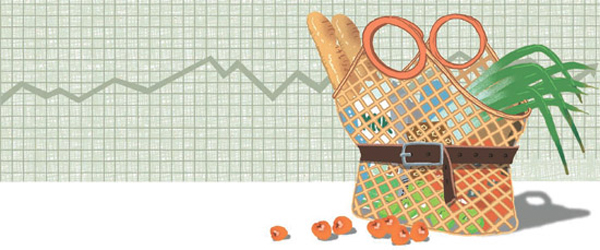More to truth than just statistics

Recently, the Financial Times raised suspicions that the manufacturing sector’s PMI (purchasing managers’ index) released by the Chinese government in July may have been manipulated. The official number shows expansion while an independent survey by HSBC suggests a deterioration of business conditions. Economic statistics are used to diagnose trends in the market and predict the future. But when statistics reflect wishful thinking, they no longer function as forecasts.
Similarly, I am at a loss when I look at our government’s official statistics. They seem far from reality. For example, I found the recently released consumer price index hard to believe. Officially, consumer prices rose at an annual rate of 1.4 percent in July, and the government calls the prices stable, noting that they’ve been rising at 1 percent annually for nine consecutive months.
But I must not be the only one shocked whenever I have gone grocery shopping in the past nine months. Since I don’t keep a meticulous record of my purchases, I cannot say precisely how much prices have gone up or down. Nevertheless, I buy less and pay more. Prices at cafes and restaurants keep going up, too, by 500 won ($0.45) here or 1,000 won there.
Real-world prices are not stable. The Bank of Korea’s expected inflation rate was 2.8 percent in June, more than twice the consumer price index’s 1 percent. The Ministry of Security and Public Administration surveyed the cost of living for average citizens in metropolitan cities and provinces around the nation in the first half of the year. The price of haircuts went up 16 percent and lodging 12.4 percent. Prices for common food items, such as naengmyeon (cold noodles) and bibimbap (rice mixed with vegetables), are 5 percent to 6 percent higher.
Lately, the government and dairy industry are fighting over milk prices. Companies want to raise the retail price because of a hike in raw milk prices, but the government is putting on the brakes to keep consumer prices stable. An adjustment seems necessary because companies are trying to raise prices more than raw milk price increase. If milk prices go up, the stability of the consumer price index may come to an end next month.
But will our daily lives be any easier or more stable when milk prices are controlled and “low and stable prices” are statistically maintained? We all know that good statistics don’t make reality any more beautiful.
*The author is an editorial writer of the JoongAng Ilbo.
by YANG SUNNY
10여 년 전에 급부상하는 중국 경제현장을 돌면서 취재한 적이 있다. 당시 중국의 각 시(市)·성(省) 정부와 중앙정부가 내놓은 경제 관련 통계자료들을 한 트렁크 꽉 채워 가져왔었다. 한데 자료를 분석하면서 난관에 부닥쳤다. 예를 들어 어느 성의 산업별 생산비중을 다이어그램으로 표시한 통계의 경우, 다 합치니 120%가 넘었다. 공식 통계들인데도 이 같은 '폭탄'은 곳곳에서 돌출했다. 그러더니 최근 중국당국이 발표한 7월 제조업 구매관리자지수(PMI)를 놓고 파이낸셜타임즈(FT) 등이 조작의혹을 제기했다. 정부 공식 발표 지수는 경기가 확장되고 있음을 보여주는데, HSBC은행이 발표한 PMI는 경기가 위축되고 있는 양상을 보여주는 정반대 결과가 나와서다. 원래 경제 통계는 경제 트렌드와 방향을 진단하고, 향후를 전망하는 데 활용된다. 한데 이렇게 기본에서 흔들리거나 실상이 아닌 희망사항을 푼 듯한 통계라면 자료로써 가치가 없으니 안 쓰면 된다. 한데 공신력 있고 조작의혹도 없는 통계가 현 상황과 어긋나는 모양새를 하고 있으면, 난감하고 약이 오른다. 최근 정부가 발표한 소비자물가지수 통계를 보면서 든 느낌이 그랬다. 7월 소비자물가 상승률은 1.4%. 정부는 9개월 연속 1%대로 '저물가 안정세를 유지'하고 있다는 해설도 붙였다. 물론 무상보육 등의 복지정책이 확대되면서 물가상승률을 끌어내리는 등 착시를 가져온 부분도 있으니 통계는 정확할 거다. 그런데 그 9개월째 시장 갈 때마다 '허걱'하고 놀라는 사람은 나뿐일까? 물론 꼼꼼히 가계부 정리해 대조하는 알뜰주부가 아닌 탓에 작년보다 뭐가 얼마나 올랐는지 들이댈 수는 없다. 한데 늘 장바구니에 담는 물건은 주는데 금액은 늘고, 동네 카페나 분식집에 가도 500~1000원씩 슬금슬금 오른다. 생활물가는 저물가 안정세가 아니다. 한국은행의 기대인플레이션율은 6월 2.8%였다. 1%대인 지표물가보다 체감물가가 2배 이상 높다는 말이다. 안전행정부의 올 상반기 전국 광역시도의 서민생활물가를 보면 미용료는 16%, 숙박료는 12.4%, 냉면·비빔밥·칼국수 등은 5~6%씩 올랐다. 요즘은 우유값을 놓고 정부와 업계가 기싸움 중이다. 업계는 원유값이 올랐다며 소비자가격을 올리려고 하고, 정부는 물가안정을 이유로 제동을 걸고 있단다. 물론 업체들이 원유가 인상폭보다 소비자가격을 더 높이려고 한다니 조정은 필요해 보인다. 또 우유값이 오르면 다음달 소비자물가지수의 안정 기조가 망가질지도 모른다. 한데 우유값만 무작정 붙잡아 통계적 '저물가 안정세'를 구현한다고 이 팍팍한 생활이 안정될까? 우리는 안다. 통계가 아름답다고 실상까지 아름다워지지는 않는다는 것을. 양선희 논설위원










with the Korea JoongAng Daily
To write comments, please log in to one of the accounts.
Standards Board Policy (0/250자)